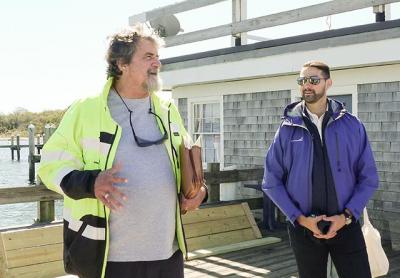Boat Ride to View Block Island Wind Farm

Seventy residents of the South Fork, some of them elected officials and others hoping to be, sailed from Montauk to the Block Island Wind Farm Monday for an up-close look at the nation’s first offshore wind-energy installation. On Block Island, officials of Deepwater Wind, the Rhode Island company that built the five-turbine wind farm and plans to construct the larger South Fork Wind Farm in federal waters approximately 36 miles from Montauk, described and answered questions about both of the projects.
Renewable Energy Long Island, a nonprofit advocacy organization, hosted the excursion in collaboration with Deepwater Wind.
Three miles from the island, in waters 75 to 90 feet deep, each turbine stands some 600 feet high when the blade is vertical. On Monday, the blades, 240 feet long, spun slowly and silently on three of the turbines; the others, according to Deepwater officials, were inactive while maintenance was being performed. Each foundation, rising 70 feet out of the water, weighs more than 1,500 tons.
The 30-megawatt Block Island Wind Farm began operation in December. It produces, according to Clint Plummer, Deepwater Wind’s vice president of development, about 10 times the island’s electrical needs in a given year. “This project brings power ashore, plugs in and delivers directly to the grid here in Block Island, and includes a separate line going from Block Island back to the mainland,” he said, detailing the “export” cable that transmits electricity from the wind farm to a substation on the island and a separate, “sea-to-shore” cable, owned by National Grid, that delivers electricity from there to the mainland. If the wind farm produces less than the island’s needs, the bi-directional sea-to-shore cable can draw power from the mainland, he said.
The installation’s five turbines effectively replaced five diesel generators upon which the island had relied for electricity, said Bryan Wilson, the Block Island Wind Farm’s manager. Those generators burned around one million gallons of fuel per year, he said. Residents, said Mr. Wilson, who has lived on the island year round since 1985, were subject to “severe fluctuations in our cost of electricity.” That was especially problematic, he said, because, like the SouthFork, “we’re a seasonal community with a lot of folks that make their money on tourism.”
The sea-to-shore cable, he said, “offers us the stability of being tied into the mainland grid that we didn’t have before. As people are fond of saying now, our clocks don’t run slow or too fast. Before, we would have to replace appliances every three to four years because the voltage was so ‘dirty’ out here.”
The group stood in the parking lot of Fred Benson Town Beach, above the buried concrete vaults where the cables, which are buried four to six feet below the sea bottom and underground to the substation, make landfall. Situating that junction at what is a very crowded location in the summer “was a concern for locals,” but “everything is armored,” Mr. Wilson said, detailing the poured-concrete blocks that house the infrastructure. Construction occurred in the winter months. The town was “adequately compensated” for the use of this area. “People were happy to see it,” he said, “because they knew it was leading ultimately to this project,” the wind farm.
The Rhode Island Coastal Resource Management Council required Deepwater Wind to conduct postinstallation surveys, Mr. Wilson said, including of the electromagnetic field emanating from the transmission cables, which fishermen on the South Fork fear could disrupt marine habitat or migration patterns. When the cables are buried to their target depth of four to six feet, the electromagnetic field is minimal, he said, dropping off significantly beyond three feet from the cable. Heat emanating from the cable also dissipates beyond a level of concern, Mr. Wilson said.
Anecdotal evidence indicates no harm to the island’s lobster fishery during or after construction, Mr. Wilson said, though fishermen were displaced, and compensated, during construction.
The South Fork Wind Farm, for which Deepwater Wind plans to submit permit applications early next year, remains controversial. Commercial fishermen are generally opposed to it, particularly the initial plan to run the transmission cable through Napeague and Gardiner’s Bay. (Deepwater officials have said that they are exploring a southern, oceanside route in response to those concerns.) Republican candidates for East Hampton Town Board and the town trustees have also taken a position against the project, although Jim Grimes, a Republican trustee seeking re-election, offered qualified support, along with lingering concerns, on Monday.
“This is what we’ve been doing for years — we’ve engaged with the fishing community,” Mr. Wilson said to Julie Evans, also running for trustee on the Republican ticket, as the gathering stood at the Southeast Light, the island’s iconic lighthouse, the Mohegan Bluffs of the south shore offering a clear view of the wind farm’s five turbines. “It is understandable that there’s opposition to the introduction of this new technology into traditionally open-water areas,” he said. “Part of the discussion is to make sure that the impacts are mitigated as much as possible, if there are indeed impacts.”
Wind turbines can be positioned so that there is no impact on commercial or recreational fishing, Mr. Wilson said. Exactly how to accomplish that was a likely topic at last night’s meeting of the trustees’ harbor management committee, to which fishermen were invited.
